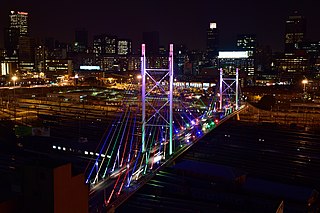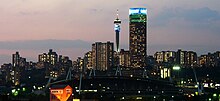
Pretoria, is South Africa's administrative capital, serving as the seat of the executive branch of government, and as the host to all foreign embassies to South Africa.

South Africa is divided into nine provinces. On the eve of the 1994 general election, South Africa's former homelands, known as Bantustans, were reintegrated into the country, and the four provinces were increased to nine. The borders of Natal and the Orange Free State were retained, while the Cape Province and Transvaal were divided into three provinces each, plus North West Province which straddles the border of and contains territory from both these two former provinces. The twelfth, thirteenth and sixteenth amendments to the Constitution of South Africa changed the borders of seven of the provinces.

Johannesburg is the most populous city in South Africa with 4,803,262 people, and is classified as a megacity; it is one of the 100 largest urban areas in the world. It is the provincial capital of Gauteng, the wealthiest province in South Africa. Johannesburg is the seat of the Constitutional Court, the highest court in South Africa. Most of the major South African companies and banks have their head offices in Johannesburg. The city is located within the mineral-rich Witwatersrand hills, the epicentre of the international-scale mineral, gold and (specifically) diamond trade.

The Province of the Transvaal, commonly referred to as the Transvaal, was a province of South Africa from 1910 until 1994, when a new constitution subdivided it following the end of apartheid. The name "Transvaal" refers to the province's geographical location to the north of the Vaal River. Its capital was Pretoria, which was also the country's executive capital.

Gauteng is one of the nine provinces of South Africa.

North West is a province of South Africa. Its capital is Mahikeng. The province is located to the west of the major population centre and province of Gauteng and south of Botswana.

The N1 is a national route in South Africa that runs from Cape Town through Bloemfontein, Johannesburg, Pretoria and Polokwane to Beit Bridge on the border with Zimbabwe. It forms the first section of the famed Cape to Cairo Road.

Gautrain is an 80-kilometre (50-mile) higher-speed express commuter rail system in Gauteng, South Africa, which links Johannesburg, Pretoria, Kempton Park and O. R. Tambo International Airport. It takes 15 minutes to travel from Sandton to O. R. Tambo International Airport on the Gautrain and 35 minutes from Pretoria in Tshwane to Park Station in Johannesburg. The Gautrain has 10 stations. Buses, shuttles and midibus services are available to transport passengers to and from all stations excluding the O. R. Tambo International Airport Station.

The R21 is a major north–south provincial route in eastern Gauteng Province, South Africa. Built in the early 1970s, it remains one of two freeways linking Pretoria with Johannesburg, via the R24. As the eastern of the two freeways, it links the Pretoria city centre with OR Tambo International Airport and Boksburg. Between the Solomon Mahlangu Drive on-ramp in Monument Park, Pretoria, and the N12 interchange in Boksburg, the R21 is an 8 lane highway and motorway (freeway), with 4 lanes in each direction. It has off-ramps leading to Irene, Olifantsfontein, Benoni, and Kempton Park. The route intersects the N1 highway near Centurion, the R24 near the airport, the N12 and N17 in Boksburg, and the N3 near Vosloorus on the East Rand, where it ends. The section from the N12 to the N3 is not a freeway. The R21 is also designated as the P157.

South Africa switched to a closed numbering system effective 16 January 2007. At that time, it became mandatory to dial the full 10-digit telephone number, including the zero in the three-digit area code, for local calls. Area codes within the system are generally organized geographically. All telephone numbers are 9 digits long, except for certain Telkom special services. When dialed from another country, the "0" is omitted and replaced with the appropriate international access code and the country code +27.

Kaya FM 95.9 is a commercial radio station that broadcasts from Johannesburg, Gauteng, South Africa.

South Africa has a 'hybrid' or 'mixed' legal system, formed by the interweaving of a number of distinct legal traditions: a civil law system inherited from the Dutch, a common law system inherited from the British, and a customary law system inherited from indigenous Africans. These traditions have had a complex interrelationship, with the English influence most apparent in procedural aspects of the legal system and methods of adjudication, and the Roman-Dutch influence most visible in its substantive private law. As a general rule, South Africa follows English law in both criminal and civil procedure, company law, constitutional law and the law of evidence; while Roman-Dutch common law is followed in the South African contract law, law of delict (tort), law of persons, law of things, family law, etc. With the commencement in 1994 of the interim Constitution, and in 1997 its replacement, the final Constitution, another strand has been added to this weave.
Koreans in South Africa form the largest Korean diaspora community on the African continent and the 29th-largest in the world, ahead of Koreans in Spain and behind Koreans in Italy.

Dion George is a South African politician who is currently serving as the Minister of Environment, Forestry and Fisheries since July 2024. He is a Member of Parliament for the Democratic Alliance (DA) He is the Federal Finance Chair of the DA, and is a member of the Party’s Federal Council, Federal Executive and National Management Committee. He also serves as a member–elected Trustee and Chair of the Investment Sub–Committee of the Political Office Bearers Pension Fund.

The economy of the Western Cape in South Africa is dominated by the city of Cape Town, which accounted for 72% of the Western Cape's economic activity in 2016. The single largest contributor to the region's economy is the financial and business services sector, followed by manufacturing. Close to 30% of the gross regional product comes from foreign trade with agricultural products and wine dominating exports. High-tech industries, international call centres, fashion design, advertising and TV production are niche industries rapidly gaining in importance.

The Gauteng Division of the High Court of South Africa is a superior court of law which has general jurisdiction over the South African province of Gauteng and the eastern part of North West province. The main seat of the division is at Pretoria, while a local seat at Johannesburg has concurrent jurisdiction over the southern parts of Gauteng. Dunstan Mlambo has been the Judge President of the division since 1 November 2012.

Garth Graham April is a South African rugby union player who most recently played for the NTT Communications Shining Arcs in the Top League in Japan. His regular position is fullback, but he can also play as a fly-half or centre.
The Gauteng Department of Roads and Transport is a department of the Government of Gauteng. It is responsible for the development of the transport system in the Gauteng province of South Africa, and for constructing and maintaining buildings and other structures for the other departments of the provincial government.

















